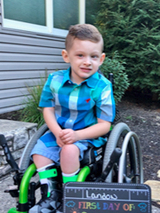Thoracic Insufficiency Syndrome and Spina Bifida: Landon’s Story
Thoracic Insufficiency Syndrome and Spina Bifida: Landon’s Story
Lindsay and David faced a difficult choice. Their 4-year-old son, Landon, was gravely ill from complications of spina bifida and scoliosis. He needed a ventilator to breathe at night, slept most of the day, and wasn’t gaining weight.

A specialized surgery at Children’s Hospital of Philadelphia (CHOP), held promise, but with Landon’s fragile condition, it also carried risks. Called vertical expandable prosthetic titanium rib (VEPTR) surgery, its aim was to straighten the curve in Landon’s spine and relieve the pressure on his lungs. The couple realized their options were limited. They scheduled the surgery.
Surgery for spina bifida
Lindsay learned through prenatal screening that her baby had a neural tube defect. An ultrasound confirmed spina bifida, a birth defect in which an area of the spinal column doesn’t form properly, leaving a section of the spinal cord and spinal nerves exposed. Her perinatologist in upstate New York referred her to the Center for Fetal Diagnosis & Treatment at CHOP. Lindsay and David traveled 4 ½ hours from their home to CHOP, where Lindsay underwent an extensive two-day evaluation for fetal surgery. They learned Lindsay was a candidate for surgery to repair the opening in their baby’s back in utero. But then doctors discovered a placental abnormality that made fetal surgery too dangerous to attempt. Lindsay and David were heartbroken but made plans to return to CHOP for a caesarean section and postnatal repair of the lesion.
Landon was delivered in August 2013, at CHOP’s Garbose Family Special Delivery Unit. Twelve hours later, he had surgery to close the opening in his spine.
The complications from the spina bifida have been considerable. Landon is paraplegic, with no sensation below his armpits. He has a shunt to manage hydrocephalus and has neurological issues that affect his ability to digest food. He has a jejunostomy tube (J-tube) so he can receive nutrition directly into his small intestine. When Landon was 18 months old, he developed scoliosis, a curvature of the spine. Over the next year, the curve progressed at an alarming rate, reaching 112 degrees (anything above 40 degrees is considered severe). He also developed kyphosis, a forward curvature of the spine in the upper back. The scoliosis and kyphosis twisted Landon’s body into a permanent ‘L’ shape. His internal organs were being crowded, he could no longer drink, his lung function dropped to 17 percent. At 4 years old, Landon weighed just 19 pounds.
Vertical expandable prosthetic titanium rib (VEPTR) surgery
Lindsay and David once again turned to CHOP, where a team of physicians at the Wyss/Campbell Center for Thoracic Insufficiency Syndrome diagnosed him with thoracic insufficiency. Landon’s thorax — the part of the body between the neck and abdomen — lacked sufficient space to support normal breathing or lung growth. Orthopaedic surgeon Patrick J. Cahill, MD, told the family about an innovative procedure he could perform. It would involve specific components of the VEPTR device in combination with magnetic growing rods. Landon’s spine and chest wall could continue to grow as he grew, but instead of repeated surgeries to lengthen the device, this could be done in the office during an outpatient visit every three months.
Lindsay and David agreed to the surgery, knowing without it, their son’s prognosis was grim. It would be done in two stages, with the devices being placed on his left side first. The second surgery would wait until Landon was stronger.
A new beginning

Now, months later, Landon has enough energy to explore the kitchen cupboards while his mom is cooking dinner. Lindsay is delighted when she notes for the first time in her son’s life, she has had to childproof their home.
“He’s exploring, he’s getting into trouble, all the things you expect of a 4-year-old,” Lindsay says.
The surgery went smoothly and Lindsay says she’s nothing short of astonished by the results. Before the surgery, Landon missed 86 days of school. In the months since the surgery, he hasn’t missed a single day because of sickness. His lung function has improved to the point where he no longer needs his ventilator at night. He loves being in his wheelchair and has enough energy now to push it around and explore his home. Lindsay was cooking dinner in the kitchen recently when Landon found a spritz-bottle of glass cleaner in a cabinet. He sprayed his foot.
“He said, ‘Look at this!’” Lindsay remembers. “He never knew what the rules were because we never had to talk about it before. As I was telling him not to do that, inside, I was celebrating.”